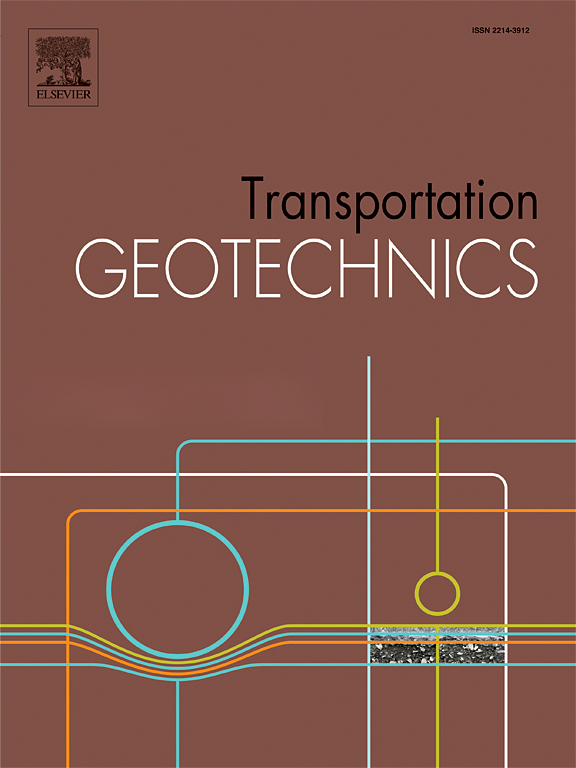多层土工合成筋桩支撑路堤模型试验研究及分析设计模型评价
IF 4.9
2区 工程技术
Q1 ENGINEERING, CIVIL
引用次数: 0
摘要
单层和多层土工合成材料加固桩支撑(GRPS)堤坝在实践中得到广泛应用。人们开发了各种分析设计模型来分析 GRPS 堤坝。然而,工程经验表明,多层土工合成材料加固路堤的性能与单层土工合成材料加固路堤的性能有所不同。这些基于不同假设的分析设计模型的适用性尚未得到充分验证。本文对多层 GRPS 路堤进行了物理模型试验,以明确其宏观力学性能。根据物理模型试验的结果,以起拱效率和钢筋应变为比较参数,评估了八个分析设计模型在不同相对路堤高度下的性能。物理模型试验结果表明,与提高单层 GRPS 路堤的加固强度相比,增加 GRPS 路堤的加固层数能更显著地提高其荷载传递和变形控制性能。与单层加固所表现出的膜行为不同,多层加固的机理更接近于梁行为,因为加固层与颗粒填料之间存在互锁关系。此外,在预测起拱效率和加固应变时,分析设计模型的预测精度与路堤相对高度呈正相关。选定的分析设计模型在预测钢筋应变方面的准确性要弱于其对起拱效率的预测能力。最后,EBGEO 模型性能良好,该模型以极限平衡理论为基础,考虑了基土承载力,并假定加固上的覆土荷载呈三角形分布。本文章由计算机程序翻译,如有差异,请以英文原文为准。
Model tests study of multi-layer geosynthetic-reinforced pile-supported embankments and evaluation of analytical design models
Single and multi-layer geosynthetic-reinforced pile-supported (GRPS) embankments are widely used in practice. Various analytical design models were developed to analyze GRPS embankments. However, engineering experience has shown that the performance of multi-layer GRPS embankments differs from that of single-layer GRPS embankments. The applicability of these analytical design models based on different assumptions has not been fully validated. This paper conducted the physical model test on multi-layer GRPS embankments to clarify their macroscopic mechanical properties. The performance of eight analytical design models under different relative embankment heights was assessed based on the results of the physical model test, using arching efficiency and reinforcement strain as comparison parameters. The results from the physical model test indicated that increasing the number of reinforcement layers in GRPS embankments can more significantly enhance their performance in terms of load transfer and deformation control, as compared to increasing the reinforcement strength of single-layer GRPS embankments. Unlike the membrane behavior exhibited by single-layer reinforcement, the mechanism of multi-layer reinforcement is closer to beam behavior due to the interlock between the reinforcements and the granular fill. Additionally, there is a positive correlation between the prediction accuracy of analytical design models and the relative embankment height, both in predicting the arching efficiency and the reinforcement strain. The accuracy of selected analytical design models in predicting reinforcement strain is found to be weaker in comparison to their predictive capabilities for arching efficiency. Finally, the EBGEO model has good performance, which is grounded in limit equilibrium theory, considers subsoil bearing capacity, and assumes a triangular distribution of the overburden load on the reinforcement.
求助全文
通过发布文献求助,成功后即可免费获取论文全文。
去求助
来源期刊

Transportation Geotechnics
Social Sciences-Transportation
CiteScore
8.10
自引率
11.30%
发文量
194
审稿时长
51 days
期刊介绍:
Transportation Geotechnics is a journal dedicated to publishing high-quality, theoretical, and applied papers that cover all facets of geotechnics for transportation infrastructure such as roads, highways, railways, underground railways, airfields, and waterways. The journal places a special emphasis on case studies that present original work relevant to the sustainable construction of transportation infrastructure. The scope of topics it addresses includes the geotechnical properties of geomaterials for sustainable and rational design and construction, the behavior of compacted and stabilized geomaterials, the use of geosynthetics and reinforcement in constructed layers and interlayers, ground improvement and slope stability for transportation infrastructures, compaction technology and management, maintenance technology, the impact of climate, embankments for highways and high-speed trains, transition zones, dredging, underwater geotechnics for infrastructure purposes, and the modeling of multi-layered structures and supporting ground under dynamic and repeated loads.
 求助内容:
求助内容: 应助结果提醒方式:
应助结果提醒方式:


